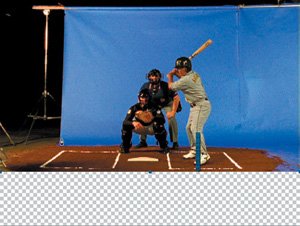Tracking for Rotoscoping
Other compositing programs, such as Apple's Shake, allow you to track mask vertices, something that is not directly possible in After Effects. So you should give up on the idea of trying to make rotoscoping easier using the tracker, right?
Wrong, of course. I feel a little sheepish writing something so obvious amongst more advanced After Effects tips, but the number of times I've seen fellow artists overlook situations where the tracker would help compels me to bring this up.
Although you cannot track individual mask points to animate an articulated mask, you'll encounter numerous cases where precise tracking is required but the matte retains a more or less constant shape. For example, you might want to add a traveling garbage matte for a green-screen shot with a moving camera, and one of its edges should be tightly tracked to a boundary on the set.
The figures in this section feature a shot in which exactly this was the case. If the front boundary of the garbage matte were not precisely tracked, distracting chatter would result.
Notes
Silhouette FX (www.silhouettefx.com) offers a plug-in with an integrated motion tracker for applying motion data to mask points.
Although it's true that there's no way to apply track data (or any transform data) directly to masks, you can work around the problem, as long as you're not actually attempting to articulate the masks using the tracker. Here's how:
- Line up a solid (with or without a mask) to mask out the layer (Figures 8.33a and b).
Figures 8.33a and b. This plate requires garbage mattes on all sides (a), but the precision of the front edge is essential as the shot dollies in (down the rails). The first step is just to add a solid where the front edge of the action area should be (b). (Baseball images courtesy Tim Fink Events & Media.)

- Track the background plate and apply the track to the solid. Reposition it (either selecting all Position keys or using the anchor point values) as needed.
- Apply this masked solid as an alpha track matte to the layer you're masking (Figure 8.34).
Figure 8.34. The tracking keyframes applied to the alpha matte layer can be seen moving vertically, holding it in place as the shot dollies in.

Once you get it working, you may actually enjoy creating garbage mattes, thanks to this extra boost of automation.
Paint, of course, is a different story and a much simpler situation once you're comfortable with the basics of expressions. Each paint stroke contains its own transform properties, including a Position property, separate from the layer's Position property. Using the pickwhip, you can link this property directly to tracking data. (For more details, see "Tracking Brushes and Effects" in Chapter 10.)
Using 3D Tracking Data |
Section I. Working Foundations
The 7.0 Workflow
- The 7.0 Workflow
- Workspaces and Panels
- Making the Most of the UI
- Settings: Project, Footage, Composition
- Previews and OpenGL
- Effects & Presets
- Output: The Render Queue
- Study a Shot like an Effects Artist
The Timeline
- The Timeline
- Organization
- Animation Methods
- Keyframes and The Graph Editor
- Uber-mastery
- Transform Offsets
- Motion Blur
- Manipulating Time Itself
- In Conclusion
Selections: The Key to Compositing
- Selections: The Key to Compositing
- The Many Ways to Create Selections
- Compositing: Science and Nature
- Alpha Channels and Premultiplication
- Masks
- Combining Multiple Masks
- Putting Masks in Motion
- Blending Modes: The Real Deal
- Track Mattes
Optimizing Your Projects
- Optimizing Your Projects
- Navigating Multiple Compositions
- Precomposing and Nesting
- Adjustment and Guide Layers
- Understanding Rendering Order
- Optimizing After Effects
- Onward to Effects
Section II. Effects Compositing Essentials
Color Correction
Color Keying
- Color Keying
- Good Habits and Best Practices
- Linear Keyers and Hi-Con Mattes
- Blue-Screen and Green-Screen Keying
- Understanding and Optimizing Keylight
- Fixing Typical Problems
- Conclusion
Rotoscoping and Paint
- Rotoscoping and Paint
- Articulated Mattes
- Working Around Limitations
- Morphing
- Paint and Cloning
- Conclusion
Effective Motion Tracking
- Effective Motion Tracking
- The Essentials
- Optimizing Tracking Using 3D
- Extending a Track with Expressions
- Tracking for Rotoscoping
- Using 3D Tracking Data
- Conclusion
Virtual Cinematography
- Virtual Cinematography
- 5D: Pick Up the Camera
- Storytelling and the Camera
- Camera Blur
- The Role of Grain
- Film and Video Looks
- Conclusion
Expressions
- Expressions
- Logic and Grammar
- Muting Keyframes
- Linking Animation Data
- Looping Animations
- Smoothing and Destabilizing
- Offsetting Layers and Time
- Conditionals and Triggers
- Tell Me More
Film, HDR, and 32 Bit Compositing
- Film, HDR, and 32 Bit Compositing
- Details
- Film 101
- Dynamic Range
- Cineon Log Space
- Video Gamma Space
- Battle of the Color Spaces
- Floating Point
- 32 Bits per Channel
- Conclusion
Section III. Creative Explorations
Working with Light
- Working with Light
- Light Source and Direction
- Creating a Look with Color
- Backlighting, Flares, Light Volume
- Shadows and Reflected Light
- HDR Lighting
- Conclusion
Climate: Air, Water, Smoke, Clouds
- Climate: Air, Water, Smoke, Clouds
- Particulate Matter
- Sky Replacement
- The Fog, Smoke, or Mist Rolls In
- Billowing Smoke
- Wind
- Water
- Conclusion
Pyrotechnics: Fire, Explosions, Energy Phenomena
- Pyrotechnics: Fire, Explosions, Energy Phenomena
- Firearms
- Sci-Fi Weaponry
- Heat Distortion
- Fire
- Explosions
- In a Blaze of Glory
Learning to See
Index
EAN: 2147483647
Pages: 157
